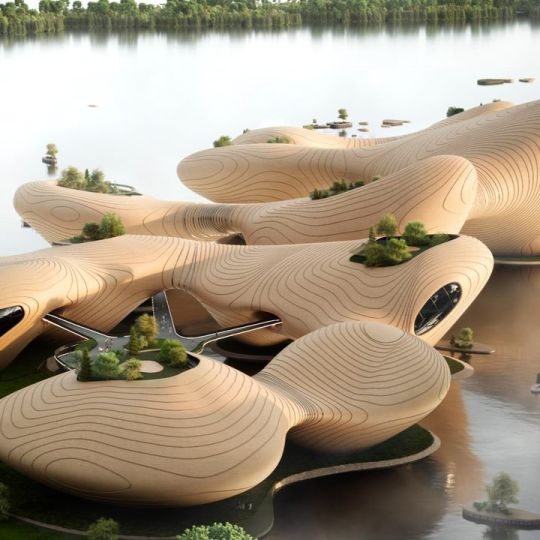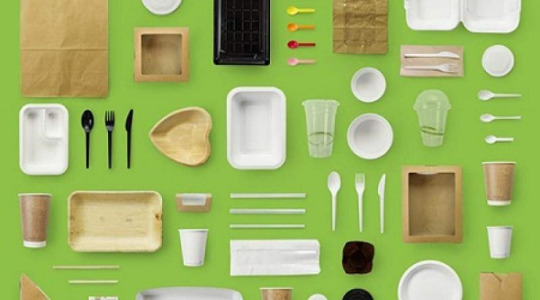#BioBasedMaterials
Explore tagged Tumblr posts
Photo

Toronto Media District by Kalbod Design Studio is a unique urban space that encourages creativity, collaboration, and community engagement. The district comprises four zones that blend seamlessly with the environment. The use of Bio-Based materials ensures water resistance, making the buildings withstand floods and water-related adversities, thus promoting sustainable and resilient urban development.
#kalboddesignstudio#torontomediadistrict#architecture#design#sustainability#resilience#urbanplanning#nature#technology#biobasedmaterials#creativity#collaboration#community#mapletreeinspired#waterresistant#futuristicdesign#greenarchitecture#urbaninnovation#architecturalvision#sustainabledevelopment#cityscape#modernarchitecture#climatechange#architecturedesign#climatechangeisreal#architecturefactor#architecturetoday#lovearchitecture#climatesolutions
2 notes
·
View notes
Text
Bio-Wax Market insights shaping global sustainability trends in 2025

Bio-Wax Market is becoming a key indicator of sustainable industry transformation as global demand rises for eco-friendly alternatives in 2025. This shift is not just driven by environmental responsibility but also by changing regulations, consumer preferences, and technological advancements that support bio-based solutions across various industries.
Introduction to Bio-Wax and Its Growing Significance
Bio-wax is a plant-based or natural-origin wax that offers a renewable alternative to traditional petroleum-derived waxes. Typically derived from sources like soy, palm, beeswax, or sugarcane, bio-wax is biodegradable and environmentally safe. As industries move toward cleaner production and sustainable practices, bio-wax is emerging as a viable replacement in sectors like cosmetics, packaging, food coatings, and even automotive care.
In 2025, this transition aligns with a wider push for sustainability, as organizations and governments globally focus on reducing carbon emissions and plastic dependency.
Sustainability Trends Driving Bio-Wax Adoption
The bio-wax market is closely linked with some of the biggest sustainability trends of 2025:
Circular Economy Goals: Companies are aiming to close the loop with biodegradable packaging and renewable raw materials.
Green Consumerism: End-users are showing preference for products labeled natural, bio-based, or eco-friendly.
Corporate Sustainability Mandates: Firms are adopting ESG (Environmental, Social, Governance) frameworks that encourage bio-material integration.
Government Regulations: Policies in the EU, US, and Asia-Pacific are increasingly mandating reduced fossil-fuel reliance in industrial materials.
These drivers have positioned bio-wax not just as a substitute but as a strategic enabler of greener supply chains.
Industrial Usage and Demand Acceleration
Bio-wax finds increasing use in:
Cosmetics & Personal Care: Lip balms, lotions, and creams use bio-wax for natural emollient properties.
Packaging: Coatings for paper and cardboard rely on bio-wax for waterproofing and compostability.
Candles & Fragrances: Consumers prefer soy or palm wax candles for their cleaner burn and organic origin.
Automotive & Industrial Lubricants: Bio-wax is used for rust prevention and lubrication in environmentally sensitive operations.
In 2025, demand is strongest in North America and Europe due to early regulatory adoption, but Asia-Pacific is catching up quickly due to scalable production capabilities and growing domestic awareness.
Innovation and Technology Trends
Innovation is playing a major role in bio-wax market expansion:
Advanced Extraction Techniques: Technologies that improve yield from plant oils make production more efficient and cost-competitive.
Bioengineering: Genetically modified crops with higher wax yields are being explored to meet rising demand.
Custom Formulations: Blended waxes optimized for specific industrial or aesthetic use cases are being developed rapidly.
Low-Carbon Processing: Manufacturers are investing in production lines with minimal environmental footprints.
These technological developments are reducing the cost gap between bio-wax and petroleum wax, encouraging wider adoption.
Challenges Facing the Bio-Wax Market
Despite its promise, the market faces a few limitations:
High Production Costs: Raw material variability and small-scale production make bio-wax costlier than synthetic alternatives.
Supply Chain Constraints: Limited access to consistent quality feedstock can affect product uniformity.
Competition with Food Supply: Use of edible crops for wax production sometimes raises food security concerns.
Standardization Gaps: Lack of global standards makes product performance inconsistent across markets.
Tackling these challenges will be crucial for long-term scalability and mainstream industry integration.
Forecast for 2025 and Beyond
The bio-wax market is expected to continue growing steadily, supported by:
Increasing product launches with natural ingredients
Strong branding around sustainability and ethical sourcing
Collaborative efforts between governments and manufacturers for greener alternatives
Investments from major chemical players in bio-based R&D
With innovations streamlining production and consumers seeking eco-labels, bio-wax is poised to play a significant role in the materials sector of the green economy.
Conclusion
In 2025, bio-wax is not just a product but a reflection of where global industry is heading. It represents the merging of sustainability goals, innovative science, and evolving consumer values. Companies that invest early in understanding and integrating bio-wax into their products or processes stand to benefit in reputation, compliance, and long-term profitability.
#biowaxmarket#sustainability2025#greenchemicals#biobasedmaterials#renewableresources#cleantechnology#ecofriendlyproducts#cosmeticindustrytrends#biowaxinnovation#circulareconomy
0 notes
Link
#ArchitecturalInnovation#biobasedmaterials#ecofriendlybuilding#greenconstruction#RegenerativeDesign#sustainablematerials
0 notes
Photo

Toronto Media District by Kalbod Design Studio is a unique urban space that encourages creativity, collaboration, and community engagement. The district comprises four zones that blend seamlessly with the environment. The use of Bio-Based materials ensures water resistance, making the buildings withstand floods and water-related adversities, thus promoting sustainable and resilient urban development.
#kalboddesignstudio#torontomediadistrict#architecture#design#sustainability#resilience#urbanplanning#nature#technology#biobasedmaterials#creativity#collaboration#community#mapletreeinspired#waterresistant#futuristicdesign#greenarchitecture#urbaninnovation#architecturalvision#sustainabledevelopment#cityscape#modernarchitecture#climatechange#architecturedesign#climatechangeisreal#architecturefactor#architecturetoday#lovearchitecture#climatesolutions
0 notes
Text
Synthetic And Bio-based Polypropylene Market: Detailed Insights on Size, Share, Growth Potential
The global synthetic and bio-based polypropylene market size is expected to reach USD 178.8 million by 2030, registering a CAGR of 8.8% from 2024 to 2030, according to a new report by Grand View Research, Inc. Growth of key end-use industries such as packaging and automotive in Asia Pacific is expected to drive the global polypropylene market the forecast period. In addition, increasing construction spending particularly in emerging markets of China, India, and Indonesia is also expected to have a positive influence on market growth.

Synthetic And Bio-based Polypropylene Market Report Highlights
Injection molding dominated the market and accounted for a market revenue share of 48.4% in 2023. Polypropylene's attributes, such as high impact resistance, chemical inertness, and ability to be molded into complex shapes, make it highly suitable for injection molding applications.
The Asia Pacific synthetic and bio-based polypropylene market dominated in 2023. This growth owes to significantly increasing environmental awareness and government regulations.
Bio-based polypropylene demand is more dominant in emerged markets of North America and Europe. These markets are characterized by stringent regulations and aware consumers regarding the environmental hazards caused due to petrochemical-based polypropylene.
For More Details or Sample Copy please visit link @: Synthetic And Bio-based Polypropylene Market Report
Volatile propylene prices on account of constantly fluctuating crude oil prices are expected to remain a key challenge for market participants. Stringent environmental regulations regarding the production and disposal of polypropylene are also expected to degrade the market growth over the forecast period. In order to overcome these issues, major participants have shifted their focus towards the development of sustainable polypropylene.
Injection molding emerged as the leading application segment and accounted for 46.1% of total market volume in 2014. The shift towards the replacement of the steel automotive industry in order to improve the fuel efficiency of automobiles is expected to remain a key driving factor for this segment over the forecast period. Films are expected to witness the highest growth rate of 5.7% from 2015 to 2022. Growing demand for BOPP films for a myriad of applications is expected to drive this segment over the forecast period.
List of major companies Synthetic And Bio-based Polypropylene Market
Braskem
Dow Inc.
Borealis AG
LyondellBasell Industries Holdings B.V.
Total S.A.
Trellis Bioplastics
BioAmber Inc.
NatureWorks LLC
Danimer Scientific
Novamont S.p.A.
FKuR Kunststoff GmbH
For Customized reports or Special Pricing please visit @: Synthetic And Bio-based Polypropylene Market Analysis Report
We have segmented the global synthetic and bio-based polypropylene market based on application, end-use, and region.
#BioPolypropylene#SyntheticPolypropylene#Polypropylene#BioBasedMaterials#SyntheticPolymers#SustainableMaterials#GreenChemistry#PlasticsIndustry#BioPolymers#EcoFriendlyPlastics#InnovationInMaterials#PolymerScience#BioPlastics
0 notes
Link
#biobasedmaterials#CES2024#Faurecia#Forvia#ForviaAirVision#ForviaHorizon#ForviaLightTile#ForviaSkylineForviaeMirrorSafeUX#ForviaSupremoseat#Futurride#Hella#HellaFlatLightµMX#human-machineinterface#ScienceBased#Scope1emissions#Scope2emissions#Scope3emissions#sustainablemobility
0 notes
Photo

😎 What makes innovation stand out in sunglasses? At QUICK WONDER, it’s in the details you don’t see — like seamless transitions. This frame is made with M49 Bioplastic, a next-gen sustainable material. What sets it apart? The precision-sculpted outer surface — lower down also with mirror gloss — delivering a seamless, polished finish rarely seen in this material class. Ordinary materials can’t. We can. This isn’t just eyewear — it’s a reflection of our craftsmanship and technical expertise, built for brands that demand sustainability and precision. 🌱 Sustainable 🔬 Technically advanced ⚙️ Scalable Let’s create something iconic.👇 www.quickwonder.com #QuickWonder #EyewearManufacturer #SustainableEyewear #M49Bioplastic #BioBasedMaterials #MirrorGloss #PrecisionCraftsmanship #MadeToScale #B2BEyewear #EcoInnovation #InvisibleDetail
0 notes
Text
Corn Fiber Market Is About to Blow Up! 🌽📈 $2.5B by 2034?!
Corn Fiber Market is gaining momentum as industries recognize its potential across various applications. From food and beverages to animal feed and sustainable materials, corn fiber is emerging as a versatile ingredient that aligns with modern health and environmental trends.
To Request Sample Report : https://www.globalinsightservices.com/request-sample/?id=GIS23448 &utm_source=SnehaPatil&utm_medium=Article
With the increasing demand for dietary fibers, the food and beverage sector dominates the market, holding a 45% share. Functional foods, dietary supplements, and bakery products drive this growth, as consumers prioritize gut health and nutrition-rich diets. Meanwhile, the animal feed industry, accounting for 30% of the market, benefits from corn fiber’s role in enhancing livestock digestive health and feed efficiency. The pharmaceutical sector, with a 25% market share, leverages corn fiber for innovative drug delivery systems and prebiotic formulations.
Geographically, North America leads the market due to advanced agricultural practices and a strong focus on wellness trends. Europe follows, driven by the increasing demand for natural and organic ingredients. The Asia-Pacific region is witnessing rapid growth, fueled by urbanization and an expanding middle-class population.
Technological advancements such as enzymatic hydrolysis and fermentation are unlocking new possibilities for bioplastics and biofuels, positioning corn fiber as a key player in the sustainability movement. The market volume, estimated at 200 million metric tons in 2024, is projected to reach 350 million metric tons by 2028.
Major industry players like Archer Daniels Midland, Cargill, and Roquette Frères are driving innovation through strategic partnerships and product diversification.
#cornfiber #dietaryfiber #foodinnovation #healthylifestyle #guthealth #functionalfoods #animalfeed #sustainableagriculture #bioplastics #biofuels #prebiotics #digestivehealth #foodscience #nutritiontrends #organicfood #naturalproducts #fiberfoods #healthyliving #sustainabilitymatters #bakerytrends #dairyindustry #confectionerytrends #pharmaceuticalindustry #textileinnovation #wellnessmovement #foodtech #plantbased #cleanlabel #feedadditives #fermentationtechnology #enzymatichydrolysis #agriculturetech #biobasedmaterials #greenenergy #alternativeprotein #precisionnutrition #foodsupplements #fmcg #healthfoods #futureofnutrition
0 notes
Text
Bioinspired Composite Materials – A Market Set to Soar to $10.8B by 2034!
Bioinspired Composite Materials Market is set to grow at a CAGR of 9.9%, driven by innovations in nanotechnology, sustainable materials, and biomimetic engineering. By mimicking nature’s efficiency, these materials enhance strength, flexibility, and sustainability, making them ideal for industries like aerospace, automotive, and biomedical applications.
To Request Sample Report : https://www.globalinsightservices.com/request-sample/?id=GIS10887 &utm_source=SnehaPatil&utm_medium=Article
Key Growth Drivers & Trends
✔ Automotive Sector Leads: Lightweight, high-strength bioinspired materials improve fuel efficiency and durability. ✔ Aerospace Sector Expands: Demand for stronger, lighter components fuels adoption. ✔ North America Dominates: Technological advancements and high R&D investments drive regional growth. ✔ Europe Follows: Strict sustainability regulations and innovations in materials science accelerate market expansion. ✔ Key Players Innovating: Hexcel Corporation, Toray Industries, and Mitsubishi Chemical Corporation lead market advancements.
Market Segmentation
🔹 By Type: Natural Polymer-Based, Synthetic Polymer-Based, Metal-Based, Ceramic-Based 🔹 By Product: Films, Fibers, Foams, Coatings, Nanocomposites 🔹 By Application: Biomedical, Aerospace, Automotive, Construction, Packaging, Marine, Textiles 🔹 By Technology: Self-Healing, Adaptive, Self-Cleaning, Energy Harvesting 🔹 By Material: Chitosan, Collagen, Cellulose, Spider Silk, Keratin
Industry Outlook
📈 Market volume reached 320 million metric tons in 2024, projected to hit 520 million metric tons by 2028. Structural composites hold a 45% share, followed by functional (30%) and biomedical (25%) composites. The rise in sustainable engineering and material science innovations will further drive market expansion.
#bioinspiredmaterials #compositematerials #aerospaceinnovation #automotivetechnology #biomimicry #sustainableengineering #nanotechnology #biomedicalmaterials #futurematerials #materialsinnovation #greenmanufacturing #spidersilk #advancedmaterials #nextgentech #selfhealingmaterials #lightweightstructures #materialscience #energyharvesting #3dprinting #constructioninnovation #packaginginnovation #highperformancecoatings #marineengineering #defensetechnology #renewablematerials #smartmaterials #automotivecomposites #biomaterials #bioengineering #sustainabledevelopment #engineeringdesign #environmentaltech #futuretech #advancedmanufacturing #nanocomposites #textileinnovation #chemicalengineering #greenmaterials #industrialtech #materialsrevolution #functionalcomposites #thermalinsulation #loadbearingmaterials #biobasedmaterials #cuttingedgetechnology #innovationindesign
0 notes
Text
The Future of Tech is Made of Bread Are Metal Conductors Obsolete? | Tech Vibes
The Future of Tech is Made of Bread – Are Metal Conductors Obsolete? | Tech Vibes https://www.youtube.com/watch?v=sizIh-2mNCU Can bread replace metal in the future of technology? It may sound unbelievable, but this video explores the revolutionary potential of bio-based materials and how bread could play a surprising role in electronics. As researchers explore sustainable alternatives, metal conductors could be on their way out. eco-friendly, organic materials like bread be the future of conductive technology? We’ll explore the science, the possibilities, and what this means for the tech industry. Could the future of tech be greener, cheaper, and smarter? Find out why bread and other bio-materials might change the game. Like, comment, and subscribe for more deep dives into tech, sustainability, and future innovations! #FutureOfTech #SustainableTech #BioBasedMaterials #ConductiveMaterials #TechInnovation via Tech Vibes https://www.youtube.com/channel/UC11EmhWEC-hE6eepr5Nz8_Q March 03, 2025 at 09:28PM
#electricvehicles#innovation#adventure#futuretechnology#fastestcarintheworld#revolution#expensivecars#carstyle
0 notes
Photo

Kalbod Design Studio unveils its architectural masterpiece, the Toronto Media and Innovation Center, in the heart of Toronto. This project is strategically positioned amidst the city's bustling cultural and entertainment districts, serving as a nexus of innovation and design. Inspired by the intricate patterns of maple trees, the center's design stands out in the urban landscape, offering a refreshing contrast to conventional structures. Elevated designs ensure resilience against potential water-related challenges while using Bio-Based materials adds an extra layer of durability and sustainability. The center is not just a building—it's a statement of adaptability, aesthetics, and future-ready design. #kalboddesignstudio #toronto #architecture #innovation #design #sustainability #resilience #urbanplanning #nature #technology #biobasedmaterials #media #entertainment #culturalhub #adaptability #aesthetics #futuredesign #waterresilience #greenarchitecture #urbanlandscape #architecturalmarvel #climatechange #architecturedesign #climatechangeisreal #amazingarchitecture #architecturetoday #lovearchitecture #climatesolutions
#kalboddesignstudio#toronto#architecture#innovation#design#sustainability#resilience#urbanplanning#nature#technology#biobasedmaterials#media#entertainment#culturalhub#adaptability#aesthetics#futuredesign#waterresilience#greenarchitecture#urbanlandscape#architecturalmarvel#climatechange#architecturedesign#climatechangeisreal#amazingarchitecture#architecturetoday#lovearchitecture#climatesolutions
1 note
·
View note
Photo

Each BAV TAiLOR material is as precious as the quality of the 100% ethical Made in Italy production. #biobasedmaterials #moderncouture . . . . . #sustainableattitudes #sustainableluxury #wellness #consciousfashion #consciousdesign #sustainabledesign #slowfashion #bavtailor #recycledmaterials #certifiedmaterials #sustainablefashion #circularfashion #ethicalproduction #madeinitaly #supportsocialprojects #socialcontribution #transparency #commonobjective #wion #altaroma #vogueitalia #voguetalents https://www.instagram.com/p/B5LEQmxo2Gc/?igshid=ayb23nqoehoa
#biobasedmaterials#moderncouture#sustainableattitudes#sustainableluxury#wellness#consciousfashion#consciousdesign#sustainabledesign#slowfashion#bavtailor#recycledmaterials#certifiedmaterials#sustainablefashion#circularfashion#ethicalproduction#madeinitaly#supportsocialprojects#socialcontribution#transparency#commonobjective#wion#altaroma#vogueitalia#voguetalents
0 notes
Photo

The Toronto Media district, conceptualized by Kalbod Design Studio, showcases the future of sustainable and water-resilient urban spaces. Spread across four distinct zones, it is a melting pot for creativity and collaboration. The standout feature of these structures is their inherent resilience to water challenges. The buildings offer enhanced water resistance by utilizing Bio-Based materials, ensuring longevity even in flood-prone scenarios. Inspired by maple tree patterns, their design further aids in efficient water management, ensuring minimal water seepage and damage. In the context of the Philippines, which often grapples with water-related adversities, how can such design methodologies be the cornerstone of our urban architectural endeavors? How can we craft beautiful and battle-ready spaces against nature's unpredictabilities?
#biobasedmaterials#architecture#design#resilience#sustainability#urbanplanning#toronto#media#innovation#nature#climatechange#architecturedesign#climatechangeisreal#amazingarchitecture#architecturedose#architecturefactor#architecturetoday#lovearchitecture#climatesolutions#sensational_architecture
0 notes
Text
Understanding the Dynamics and Potential of the Bioplastic Packaging Market in a Changing World
The global bioplastic packaging market size is expected to reach USD 50.57 billion by 2030, according to a new report by Grand View Research, Inc., expanding at a CAGR of 16.9% from 2022 to 2030. The growth of the global plastics packaging industry is likely to be driven by the increasing consumption of plastics in packaging food, beverages, cosmetics, personal care, and consumer goods.

Bioplastic Packaging Market Report Highlights
The biodegradable material segment is expected to expand at the highest CAGR of 17.3% from 2022 to 2030, aided by the increasing demand for sustainable packaging, strict regulation of commercial plastics, and growing consumer preference for eco-friendly plastic
The flexible packaging segment is projected to advance at the fastest CAGR of 18.1% during the forecast period, owing to its applicability and functionality of offering excellent protection against environmental factors (air and water) to the packaged goods, wide availability, lightweight, and less complex manufacturing process than rigid packaging
Food and beverages emerged as the leading application segment and is further expected to expand at a CAGR of 17.1% from 2022 to 2030
The global bioplastics packaging market is highly competitive and fragmented in nature, with the presence of various key players such as BASF SE, NatureWorks LLC, SABIC, Braskem, M&G Chemicals, Teijin Limited, and Toray Industries, as well as a few medium- and small-scale regional players across the globe
For More Details or Sample Copy please visit link @: Bioplastic Packaging Market Report
Bioplastics are plastics that are made from renewable sources such as corn, sugarcane, potato, wheat, rice, vegetable oil, or cellulose. There are two types of bioplastics, namely biodegradable plastics and non-biodegradable plastics. Biodegradable plastics include polylactic acid, starch blends, PBAT, and PBS, while non-biodegradable plastics include polyethylene, polyethylene terephthalate, polyamide, and polytrimethylene terephthalate.
Bioplastic packaging is considered to be an environment-friendly solution and helps enhance the final product’s appearance. Growing usage of bioplastics in flexible packaging is expected to fuel market growth. The growing demand for food, due to the rising global population, is a key factor driving the demand for flexible packaging. Moreover, the packaged food industry in the U.S. and Europe has grown tremendously in recent years. Furthermore, increasing concerns regarding toxins in petrochemicals, along with depleting crude oil reserves, are driving the development of bio-based polymers.
Regulations by most governments restricting the consumption of petroleum-based plastics in certain applications such as food packaging and medical devices are expected to further incentivize bioplastic production in the plastics industry. However, the high cost as compared to conventional plastics is a major factor restraining the market growth. Currently, low prices of conventional plastics are making it difficult for bioplastics to achieve competitive pricing.
#BioplasticPackaging#SustainablePackaging#EcoFriendlyMaterials#GreenPackaging#BiodegradablePackaging#CircularEconomy#PackagingInnovation#EnvironmentallyFriendly#BioBasedMaterials#PlasticAlternatives#PackagingSolutions#Bioplastics#SustainableBusiness#GreenTechnology#PackagingTrends#EnvironmentalImpact#BioPackaging#PackagingIndustry#ReducingPlasticWaste#FutureOfPackaging
0 notes
Photo

Einstein gemaakt middels vacuumvormen met biobased plaatmateriaal uit aardappelzetmeel #plasticathermoforming #biobased #biobasedmaterials #biobasedplastics #potatostarch #duurzaam #milieu (bij Plastica Thermoforming) https://www.instagram.com/p/BwCLNBjnu72/?utm_source=ig_tumblr_share&igshid=1xhem9qcdfgjs
0 notes
Photo


😎 What makes innovation stand out in sunglasses? At QUICK WONDER, it’s in the details you don’t see — like seamless transitions. This frame is made with M49 Bioplastic, a next-gen sustainable material. What sets it apart? The precision-sculpted outer surface — lower down also with mirror gloss — delivering a seamless, polished finish rarely seen in this material class. Ordinary materials can’t. We can. This isn’t just eyewear — it’s a reflection of our craftsmanship and technical expertise, built for brands that demand sustainability and precision. 🌱 Sustainable 🔬 Technically advanced ⚙️ Scalable Let’s create something iconic.👇 www.quickwonder.com #QuickWonder #EyewearManufacturer #SustainableEyewear #M49Bioplastic #BioBasedMaterials #MirrorGloss #PrecisionCraftsmanship #MadeToScale #B2BEyewear #EcoInnovation #InvisibleDetail
0 notes